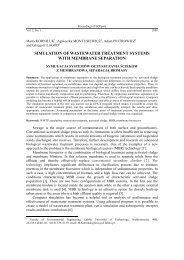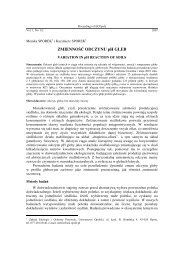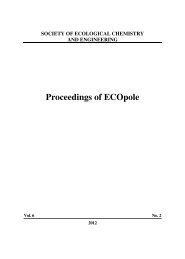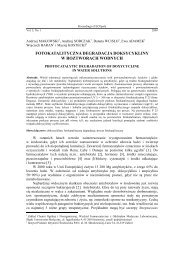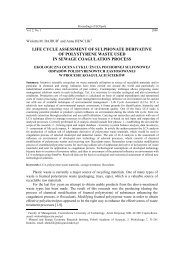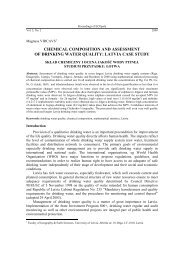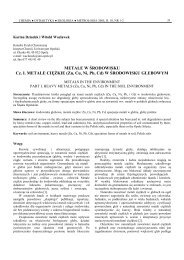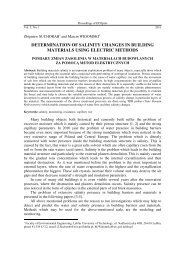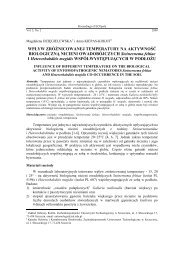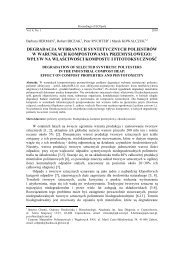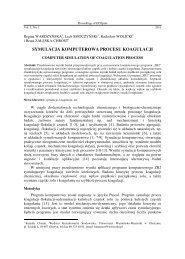HEAVY METALS BIOSORPTION FROM AQUEOUS SOLUTION BY ...
HEAVY METALS BIOSORPTION FROM AQUEOUS SOLUTION BY ...
HEAVY METALS BIOSORPTION FROM AQUEOUS SOLUTION BY ...
You also want an ePaper? Increase the reach of your titles
YUMPU automatically turns print PDFs into web optimized ePapers that Google loves.
88<br />
Sławomir Wierzba<br />
The experiment results of Cu(II) and Zn(II) biosorption and desorption are reported in<br />
Table 1. Desorption efficiency of Cu(II) and Zn(II) by living cells was 76.3 and 68.4%<br />
under 0.1 M HCl and it was 93.1 and 86.5% by non-living cells, respectively. It indicates<br />
that 0.1 M HCl can effectively desorbs the bound Cu(II) and Zn(II) from non-living cells,<br />
but not very effective for living cells. And the desorption of Cu(II) is more effective than<br />
that of Zn(II). It also may be due to the living cells uptake a part of Cu(II) and Zn(II)<br />
through intracellular accumulation, since it is possible to remove metals from cell surfaces<br />
after biosorption but not bioaccumulation [6].<br />
Conclusions<br />
Results of this study demonstrated that the binding capacity of living cells is<br />
significantly higher than that of non-living cells at tested conditions. It was also found that<br />
0.1 M HCl can effectively desorb the bound Cu(II) and Zn(II) from non-living cells, but not<br />
very effective for living cells. The results of biosorption time and desorption experiments<br />
suggested that Cu(II) and Zn(II) uptake by the living cells might be enhanced by<br />
intracellular accumulation.<br />
The results suggest that Pseudomonas sp. G1 is a potential adsorbing media for metals<br />
in the treatment of wastewater containing Cu(II) and Zn(II). So this bacterium may be<br />
employed for metal remediation in simple reactors or even in situ.<br />
References<br />
[1] Gabr R.M., Hassan S.H.A. and Shoreit A.A.M.: Biosorption of lead and nickel by living and non-living cells<br />
of Pseudomonas aeruginosa ASU 6a. Int. Biodeter. Biodegr., 2008, 62, 195-203.<br />
[2] Vijayaraghavan K. and Yun Y-S.: Bacterial biosorbents and biosorption. Biotechnol. Adv., 2008, 26,<br />
266-291.<br />
[3] Choi A., Wang S. and Lee M.: Biosorption of cadmium, copper, and lead from aqueous solution by<br />
Ralstonia sp. and Bacillus sp. isolated from diesel and heavy metal contaminated soil. Geosci. J., 2009,<br />
13(4), 331-341.<br />
[4] Chang J-S., Law R. and Chang Ch-Ch.: Biosorption of lead, copper and cadmium by biomass of<br />
Pseudomonas aeruginosa PU21. Water Res., 1997, 31(7), 1651-1658.<br />
[5] Lopez A., Lazaro N., Priego J.M. and Marques A.M.: Effect of pH on the biosorption of nickel and other<br />
heavy metals by Pseudomonas fluorescens 3F39. J. Ind. Microbiol. Biot., 2003, 24, 146-151.<br />
[6] Chen C.X., Wang P.Y., Lin Q., Shi Y.J., Wu W.X. and Chen Y.X.: Biosorption of copper(II) and zinc(II)<br />
from aqueous solution by Pseudomonas putida CZ1. Colloid. Surface B., 2005, 46, 101-107.<br />
[7] Liu Y., Cao Q., Luo F. and Chen J.: Biosorption of Cd 2+ , Cu 2+ , Ni 2+ , and Zn 2+ ions from aqueous solutions by<br />
pretreated biomass of brown alge. J. Hazard. Mater., 2009, 163, 931-938.<br />
[8] Hawari A.H. and Mulligan C.N.: Biosorption of lead(II), cadmium(II), copper(II) and nikel(II) by anaerobic<br />
granular biomass. Bioresour. Technol., 2006, 97, 692-700.



